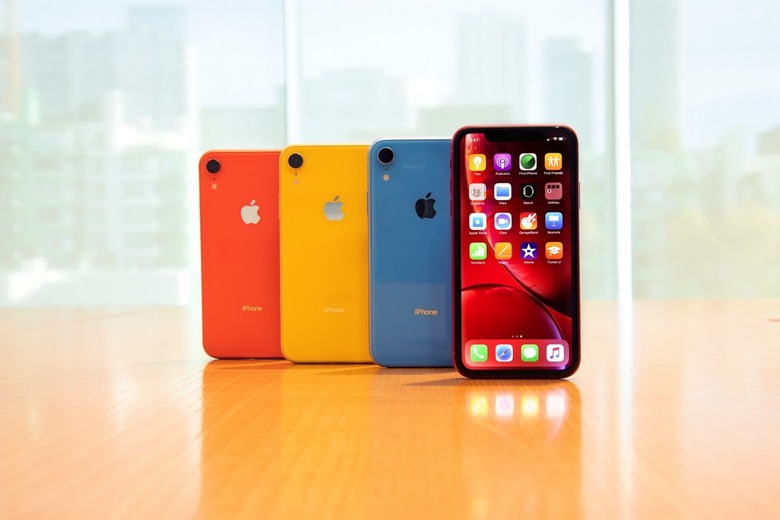Apple Has Done A Horrible Job Advertising The iPhone XR
A few days ago, I got a text from a family member asking me if it's worth buying the iPhone XRS — and no, that's not a typo. A few weeks earlier when I was home for Thanksgiving, a friend excitedly told me that he just picked up a brand new iPhone. When I asked him what model he bought, he said, "I'm not sure exactly, I think it may be the iPhone 8XR or something."
The problem here is apparent: laypeople aren't exactly sure what the iPhone XR is and Apple has done an uncharacteristically horrible job of advertising the device to the public. Also problematic is that the average person simply has no idea how the iPhone XR differs from the iPhone XS in a meaningful way. What's more, the names of the devices themselves don't help clue customers in. Sure, the iPhone XS Max can easily be pegged as a larger device, but Apple's iPhone XR/XS naming scheme is a convoluted mess that Apple has historically avoided.
In previous years, differentiating between various iPhone models was easy. You had the regular model and the Plus model that was effectively the same phone with a bigger display and better camera. It was all very simple and consumer-friendly. Further, the numbering scheme Apple has used since the very beginning was simple and informative. Without knowing anything about features or specs, any person could instantly tell you that the iPhone 5 was a step up from the iPhone 4. This year's iPhone lineup, while compelling, lacks that simplicity in a glaring way and can be downright confusing to folks who don't follow the tech news cycle with regularity. How, for example, is someone who casually upgrades their phone every 2-3 years supposed to know the difference between the iPhone XR and the iPhone XS?
Sure, Phil Schiller said that the 'R' designation was taken from race cars, but that doesn't help matters at all. Here's Schiller's official explanation as to the naming scheme Apple used this year.
I love cars and things that go fast. R and S are both letters used to denote sport cars that are really extra special.
What kind of nonsense is that? Truth be told, that's just poor advertising and is reminiscent of Android handset makers who routinely churn out devices with confusingly similar product names that can't be differentiated at a glance. If we're being honest, Apple's 2018 iPhone lineup sounds like something you'd see from Sony.
But it gets worse — even trying to explain the difference between the iPhone XR and the XS to someone is likely to lead to more confusion. Most people just stare off into space when you start talking about stuff like LCD vs OLED and 3D Touch. I think Apple took for granted how disruptive its new naming scheme was to the familiarity iPhone users have grown accustomed to over the past 11 years.
Especially in an age when people are holding onto their phones for longer periods of time, Apple had to do a much better job explaining why the iPhone XR was a worthwhile upgrade. Naturally, early adopters are going to gravitate towards the iPhone XS and XS Max, but the iPhone XR — as a mass market device that was supposed to spur an avalanche of upgrades — required a much more thoughtful ad campaign.
Even the iPhone XR ads I do see from Apple are nothing to write home about. All of the iPhone XR billboards — which Apple has up across many major cities — simply have a photo of the iPhone XR. That simplistic type of advertising may work when a device already has a little bit of momentum behind it, but it falls far short when it comes to actually informing the customer.
On a related note, John Gruber of Daring Fireball observes that the iPhone XR simply isn't as familiar a device to prospective upgraders, which is all the more reason why Apple's iPhone XR ad campaign has been nothing short of useless.
Last year, you could walk into a store and choose between two new iPhones: the new-and-different iPhone X and the new-and-familiar iPhone 8/8 Plus. This year, if you want a brand-new iPhone model, there is no "familiar" choice. The XS, XS Max, and XR all offer the same new-and-different experience.
Most previous iPhone innovations weren't disruptive to familiarity. When the iPhone 4 introduced retina displays, there was no reason for anyone to complain. When they introduced Touch ID with the iPhone 5S, they didn't take passcodes away. A skeptic suspicious that Touch ID was a mere gimmick wasn't losing anything compared to the pre-Touch ID iPhone they were upgrading from. A skeptical would-be iPhone X/XS/XR customer, on the other hand, has to willingly give up Touch ID and trust that they'll find Face ID to be an acceptable replacement.
The sad thing is that the iPhone XR is an incredibly compelling device. It offers up nearly all of the features of the pricier iPhone XS at a relatively affordable price point. The thing is, for a device that was supposed to be a breakout hit, perhaps coming up with a new naming nomenclature was misguided. And if Apple was dead set on the iPhone XR, it should have rolled out a far more engaging and informative ad campaign.
